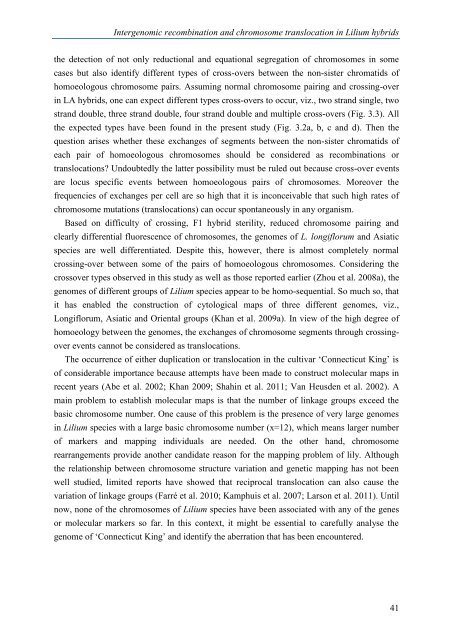A molecular cytogenetic analysis of chromosome behavior in Lilium ...
A molecular cytogenetic analysis of chromosome behavior in Lilium ...
A molecular cytogenetic analysis of chromosome behavior in Lilium ...
Create successful ePaper yourself
Turn your PDF publications into a flip-book with our unique Google optimized e-Paper software.
Intergenomic recomb<strong>in</strong>ation and <strong>chromosome</strong> translocation <strong>in</strong> <strong>Lilium</strong> hybridsthe detection <strong>of</strong> not only reductional and equational segregation <strong>of</strong> <strong>chromosome</strong>s <strong>in</strong> somecases but also identify different types <strong>of</strong> cross-overs between the non-sister chromatids <strong>of</strong>homoeologous <strong>chromosome</strong> pairs. Assum<strong>in</strong>g normal <strong>chromosome</strong> pair<strong>in</strong>g and cross<strong>in</strong>g-over<strong>in</strong> LA hybrids, one can expect different types cross-overs to occur, viz., two strand s<strong>in</strong>gle, twostrand double, three strand double, four strand double and multiple cross-overs (Fig. 3.3). Allthe expected types have been found <strong>in</strong> the present study (Fig. 3.2a, b, c and d). Then thequestion arises whether these exchanges <strong>of</strong> segments between the non-sister chromatids <strong>of</strong>each pair <strong>of</strong> homoeologous <strong>chromosome</strong>s should be considered as recomb<strong>in</strong>ations ortranslocations? Undoubtedly the latter possibility must be ruled out because cross-over eventsare locus specific events between homoeologous pairs <strong>of</strong> <strong>chromosome</strong>s. Moreover thefrequencies <strong>of</strong> exchanges per cell are so high that it is <strong>in</strong>conceivable that such high rates <strong>of</strong><strong>chromosome</strong> mutations (translocations) can occur spontaneously <strong>in</strong> any organism.Based on difficulty <strong>of</strong> cross<strong>in</strong>g, F1 hybrid sterility, reduced <strong>chromosome</strong> pair<strong>in</strong>g andclearly differential fluorescence <strong>of</strong> <strong>chromosome</strong>s, the genomes <strong>of</strong> L. longiflorum and Asiaticspecies are well differentiated. Despite this, however, there is almost completely normalcross<strong>in</strong>g-over between some <strong>of</strong> the pairs <strong>of</strong> homoeologous <strong>chromosome</strong>s. Consider<strong>in</strong>g thecrossover types observed <strong>in</strong> this study as well as those reported earlier (Zhou et al. 2008a), thegenomes <strong>of</strong> different groups <strong>of</strong> <strong>Lilium</strong> species appear to be homo-sequential. So much so, thatit has enabled the construction <strong>of</strong> cytological maps <strong>of</strong> three different genomes, viz.,Longiflorum, Asiatic and Oriental groups (Khan et al. 2009a). In view <strong>of</strong> the high degree <strong>of</strong>homoeology between the genomes, the exchanges <strong>of</strong> <strong>chromosome</strong> segments through cross<strong>in</strong>goverevents cannot be considered as translocations.The occurrence <strong>of</strong> either duplication or translocation <strong>in</strong> the cultivar ‘Connecticut K<strong>in</strong>g’ is<strong>of</strong> considerable importance because attempts have been made to construct <strong>molecular</strong> maps <strong>in</strong>recent years (Abe et al. 2002; Khan 2009; Shah<strong>in</strong> et al. 2011; Van Heusden et al. 2002). Ama<strong>in</strong> problem to establish <strong>molecular</strong> maps is that the number <strong>of</strong> l<strong>in</strong>kage groups exceed thebasic <strong>chromosome</strong> number. One cause <strong>of</strong> this problem is the presence <strong>of</strong> very large genomes<strong>in</strong> <strong>Lilium</strong> species with a large basic <strong>chromosome</strong> number (x=12), which means larger number<strong>of</strong> markers and mapp<strong>in</strong>g <strong>in</strong>dividuals are needed. On the other hand, <strong>chromosome</strong>rearrangements provide another candidate reason for the mapp<strong>in</strong>g problem <strong>of</strong> lily. Althoughthe relationship between <strong>chromosome</strong> structure variation and genetic mapp<strong>in</strong>g has not beenwell studied, limited reports have showed that reciprocal translocation can also cause thevariation <strong>of</strong> l<strong>in</strong>kage groups (Farré et al. 2010; Kamphuis et al. 2007; Larson et al. 2011). Untilnow, none <strong>of</strong> the <strong>chromosome</strong>s <strong>of</strong> <strong>Lilium</strong> species have been associated with any <strong>of</strong> the genesor <strong>molecular</strong> markers so far. In this context, it might be essential to carefully analyse thegenome <strong>of</strong> ‘Connecticut K<strong>in</strong>g’ and identify the aberration that has been encountered.41














